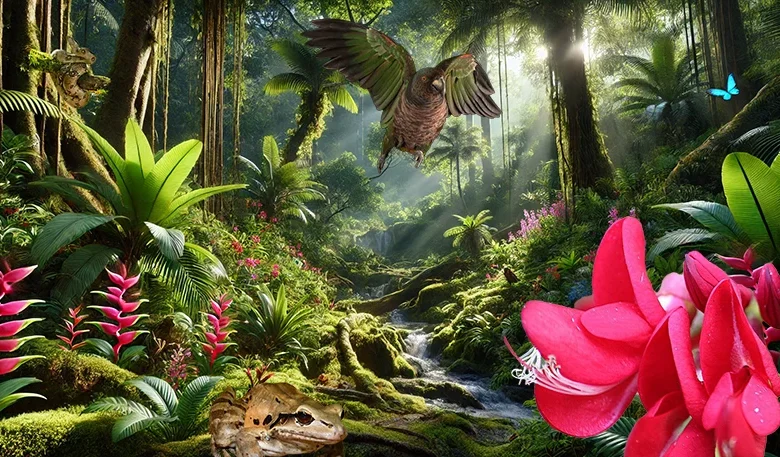Endemic Species of Dominica

Dominica, known as the “Nature Isle of the Caribbean“, is rich in biodiversity. It has an impressive array of wildlife endemic to the island, meaning they are found nowhere else on Earth. Dominica’s diverse landscapes, from coastal woodlands to mountainous rainforests, provide habitats for unique flora and fauna that have evolved in isolation, contributing to the island’s ecological richness and cultural heritage.
Endemic Species of Dominica
Dominica’s rich biodiversity includes numerous endemic species, each adapted to the island’s varied ecosystems. These species, from coastal forests to mountain rainforests, illustrate Dominica’s ecological uniqueness and highlight the island’s conservation priorities. Below is a comprehensive overview of Dominica’s endemic species across various groups, from birds and reptiles to insects and plants.
Birds
Dominica is home to three prominent endemic bird species. Two are parrots, national symbols of the island’s commitment to biodiversity conservation:
- Sisserou Parrot (Amazona imperialis) – Known locally as the Imperial Amazon Parrot, this critically endangered bird is Dominica’s national bird and found mainly in high-elevation forests.
- Jaco Parrot (Amazona arausiaca) – Also called the Red-necked Amazon Parrot, this vulnerable parrot is common in Dominica’s lower-elevation forests, though still under protection due to habitat loss.
- Kalinago Wren (Troglodytes martinicensis rufescens)—This recently identified subspecies is named in honour of the Indigenous people of Dominica, the Kalinago, and is found primarily in forested areas of the island.
Reptiles
Dominica hosts several endemic reptiles, each adapted to specific habitats across the island:
- Abòlò (Dominican Ground Lizard), Ameiva fuscata – A common sight in coastal woodlands, it plays a key role in pest control and is culturally significant.
- Zandoli or Dominican Anole (Anolis oculatus) is a versatile lizard that varies in colour across habitats, from rainforests to drier coastal areas.
- Tete-Chien (Clouded Boa Constrictor), Boa nebulosa – The largest snake on the island, it is found in forested regions and sometimes observed near cliff faces.
- Mabuya/Mabouya – Dominican Skink (Mabuya Dominicana) – Preferring leaf litter in forested areas, this skink is essential to the island’s reptilian biodiversity.
Amphibians
Dominica’s humid rainforests support several unique amphibian species:
- Dominican Coqui Frog (Eleutherodactylus amplinympha) – Known for its distinct calls, this frog inhabits Dominica’s dense forests and indicates forest health.
- Mountain Chicken (Leptodactylus fallax) – Also called the Crapaud, this large, critically endangered frog has cultural importance and faces threats from disease and habitat loss.
Invertebrates
Dominica’s endemic invertebrates include butterflies, land snails, and beetles, which contribute to the ecological balance in forest ecosystems:
- Dominican Snout Butterfly (Libytheana fulvescens) – Recognized for its snout-like mouthparts, this butterfly adds to the island’s diverse population.
- Dominican Hairstreak Butterfly (Electrostrymon dominicana) – A forest-dwelling butterfly known for its unique appearance.
- Amphibulima Browni – A native land snail adapted to the island’s humid forests.
- Amphicyclotulus dominicensis – Another snail species commonly found in Dominica’s forested regions.
- Clinidium smithsonianum – A beetle species inhabiting dense forest ecosystems.
- Naesiotus stenogyroides – An endemic snail adapted to Dominica’s microhabitats.
Plants
Dominica’s endemic plant species highlight the island’s botanical diversity, with several trees, flowering plants, and medicinally valuable species:
- Bwa Kwaib (Sabinea carinalis) – Dominica’s national flower, this tree is noted for its vibrant colors and is often used in local festivities.
- Bois Bandé (Dacryodes excelsa) – A towering tree found in rainforests, valued for its wood and medicinal properties.
- Balata (Manilkara bidentata) – A durable hardwood used traditionally for tools and construction.
- Gommier (Bursera simaruba) – Known for its medicinal uses and as a traditional canoe wood among the Kalinago.
Lesser-Known Endemics
Dominica also harbors a variety of lesser-known species, mainly invertebrates and plants adapted to its microhabitats, such as:
- Dominican Blind Snake (Typhlops dominicanus) – A rare sight due to its burrowing behavior.
- Endemic butterfly species like Memphis dominicana and Polites dictynna, which thrive in forested and mountainous areas.
- Various endemic orchids and epiphytes found within high-elevation and rainforest areas.
Conservation Efforts
Dominica’s unique endemic species face deforestation, habitat fragmentation, and climate change threats. Conservation initiatives led by the Forestry, Wildlife & Parks Division and partnerships with organizations like PROGREEN and the Global Environment Facility are crucial in protecting these species. Protected areas, including Morne Trois Pitons National Park and Northern Forest Reserve, provide safe habitats for these species while promoting eco-tourism that educates visitors on biodiversity. The key components of Dominica’s ongoing commitment to conserving its endemic species are educational programs and sustainable land-use policies.
Importance of Endemic Species to Dominica’s Identity
Dominica’s endemic species are vital for maintaining ecological balance and form a core part of the island’s cultural and national identity. Species like the Sisserou Parrot and Mountain Chicken hold significant cultural importance, are celebrated in local traditions, and symbolize Dominica’s natural heritage. The conservation of these unique species contributes to Dominica’s reputation as the “Nature Isle” and emphasizes the island’s dedication to preserving its natural beauty for future generations.




